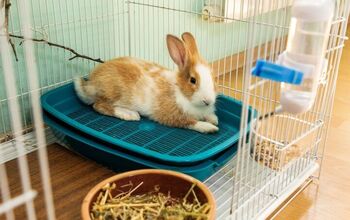Can You Leash and Harness Train a Rabbit?

Rabbits, with their adorable faces and curious personalities, are growing in popularity as companions and family members. While setting up a comfortable habitat with your rabbit’s basic needs is essential, we can’t overlook the importance of mental and physical enrichment.
There are many great products to incorporate enrichment in their cage or pen. The options are endless, from adorable food puzzles and enrichment toys to climbing structures and tasty chews. One form of enrichment I have heard discussed more lately is using a leash and harness to take your rabbit outdoors safely.
Leash training a rabbit is possible, but you must approach it with patience, understanding, and respect for their natural instincts. It’s a delicate process that requires a gentle hand and a deep understanding of your rabbit’s needs and limitations. You want to open the door to enjoyable experiences while keeping them safe.
Let’s discuss the steps to successfully leash training a rabbit and how to know if your best friend will be comfortable with this.
What Are the Benefits of Leash Training a Rabbit?
If you’re hearing about leash training a rabbit for the first time, you may be wondering why you would consider teaching your rabbit to walk on a leash. While this activity is common with dogs, seeing other pets exploring while wearing a harness is less common. Still, it is gaining popularity with a growing number of adventure cats, leash-trained small animals, and even birds and reptiles learning to use these tools to go outdoors safely.
Here are a few reasons you may want to consider introducing your rabbit to a harness and leash:
Enjoy the Outdoors Safely
There are many benefits a rabbit can enjoy from spending time outdoors, from the fresh air and sunshine to grazing on the fresh grass and clover. The new sounds, sights, smells, and experiences are a great way to enjoy mental and physical enrichment, but letting your rabbit run loose could put them at serious risk.
Unless you have a secure outdoor cage to keep your rabbit safe, leash training is the only way to take them outside while avoiding danger like potential predators, toxins, traffic, and more. Keeping your bunny on a leash means you can take steps to keep them safe if a problem arises.
Get Them Moving
Many pets today struggle with obesity. While there are several potential causes of this obesity epidemic, one problem that veterinarians and experts often see is a lack of physical activity. You can incorporate more exercise into your schedule indoors, but this could introduce risk factors like small enclosures that don’t allow enough room to hop around freely or concerns about rabbit-proofing.
The outdoors is a literal playground with plenty of space to play. Taking your rabbit out on a leash allows them to enjoy that area freely.
Prevent Boredom
Can you imagine spending all day, every day, in a small cage or enclosure? Unless you take steps to offer mental and physical enrichment opportunities to enhance your rabbit’s life, they run the risk of suffering from boredom. In time, boredom can lead to behavior problems.
Some common signs of boredom in rabbits include:
- Over-grooming
- Excessive chewing on cage bars, furniture, or other things they shouldn’t
- Digging/shredding obsessively
- Loss of interest in usual activities
- Overeating (eating out of boredom)
- Weight gain
- Uncharacteristic aggression (growling, scratching, biting)
Taking your rabbit out to spend some time outdoors on-leash is an excellent way to provide the mental stimulation they need. Each new smell and sound expands their world just a little further.
The training process is another great way to challenge your rabbit’s mind. We often think of training dogs to sit or roll over, but rabbits can also be trained to do many things. From functional “tricks” like leash training or teaching your rabbit to use a litter box to introducing tricks like “spin” and “beg,” rabbits are intelligent animals who may just surprise you!
Controlled Socialization
Nothing is wrong with your rabbit meeting and engaging with other animals, but it must be done in a controlled and safe environment. This includes meeting with humans when out and about. That said, an introduction in their cage or habitat can be stressful as they feel cornered or unsafe. It can also create ongoing stress as they no longer see their habitat as a safe place where no one else can put them in harm’s way.
Taking your rabbit out on a leash in an open space where they feel they have plenty of escape routes is a great way to approach this (assuming they are comfortable being on a leash by the time you do the introductions). It allows you to control the introductions while giving the illusion of freedom, allowing everyone to move at their own pace.
Opportunities for Quality Time
Of course, when we bring a pet into our lives, one of the most significant benefits we experience is the love and companionship they offer us. But that’s a two-way street! Spending time interacting and engaging with you is also incredibly important for your rabbit.
It’s not necessary to go outdoors to spend time together. However, if you and your rabbit both enjoy spending time outdoors, it’s a great opportunity to spend some time together and strengthen that special animal-human bond.
Are Some Rabbit Breeds Better Suited for Leash Training?
Any rabbit has the potential to enjoy spending time outdoors. However, some breeds may have natural personality traits that give them a little edge. For example, an anxious or uneasy rabbit won’t enjoy being forced into a new situation. Instead, you want to choose a rabbit that is calm even when faced with something new and unknown. Plus, some rabbit breeds are said to be easier to train.
Based on the most common personality traits of each breed, some options you may want to consider include:
Of course, within each of those breeds will be some who aren’t suited for a life of outdoor adventure. Take time to get to know your rabbit, including their personal quirks and traits. Consider whether this is an activity they will enjoy, adding to the quality of their life, or one that will put them in an unpleasant and uncomfortable situation. After all, like people, no two rabbits are the same – some rabbits are homebodies and introverts, too!
Tips for Leash Training Your Rabbit
While leash training can open up a whole new world of opportunities for exploration and bonding, it’s essential to approach this process carefully. You will need to use patience, understanding, and a gentle touch. The following tips will help you successfully introduce your rabbit to the world outside their habitat while prioritizing both their safety and comfort.
Remember, every rabbit is unique. Adapt these tips and the timeline to suit your best friend’s personality and needs.
Don’t Rush the Process
If you rush your rabbit into being outdoors on a leash and harness, the whole process can quickly become stressful and overwhelming. This can quickly turn the leash and harness into a source of anxiety. If the very sight of the harness starts your rabbit’s heart racing, they aren’t going to enjoy the experience and will resist spending any time outdoors.
The best way to avoid this mistake is to go slow and carefully observe your best friend’s non-verbal communication. This includes body language and behavioral changes that could indicate they are feeling uncomfortable.
Start by introducing the leash and harness at home in a comfortable space. Allow it to sit out where they can check it out and realize that it’s not something to be afraid of. When they are comfortable being around the harness without it upsetting them, try placing it around their neck or onto their back, depending on the harness style, but don’t fasten it. Instead, just allow them to feel the harness before taking it away and rewarding them.
In time, you can work up further by fastening the harness briefly before taking it off, extending the time they wear it, then introducing the leash and allowing the rabbit to drag it around. All this is done indoors in a familiar space before leaving the house.
If at any time you see your rabbit becoming stressed or upset, end the training session. Do something they enjoy to help them calm down and relax. You may need to take a step back or slow down the process slightly to keep them comfortable. It may seem long and tedious, but it will all be worth the effort in the end!
Find the Right Motivation
One of the best ways to make the training process a positive experience is to pair their training with a reward like a favorite treat. I always recommend taking some time before your first training session to try offering different treats and rewards and see what your rabbit gravitates to.
You can try commercial rabbit treats like Kaytee Krunch-A-Rounds, Oxbow Simple Rewards Baked Treats with Apple & Banana, or Vitakraft Drops Yogurt Treats. You can also try fresh vegetables like Romaine lettuce, spinach, broccoli, bell peppers, squash, or zucchini. Dandelions are also a hit for some rabbits.
The more excited they get for their treats, the better motivation they will provide. Consider setting up a snack board with several options and watch to see what they choose to eat first. Did they leave something uneaten? If they don’t eat it when given for free, they certainly aren’t going to work for it!
Choose the Proper Harness
There are two key things to consider when choosing the best harness for your rabbit: you want to use a comfortable and secure option to reduce the risk they will escape. However, it’s important to remember that there is no such thing as an “escape-proof” harness, regardless of how a company may market their products. This is why your rabbit should never be left on the harness unsupervised.
The two most common types of harnesses for rabbits include H-shaped harnesses and vest-style harnesses.
As the name suggests, H-shaped harnesses are shaped like the letter H. They feature two adjustable straps, one around the stomach and another around the neck. These harnesses are lightweight and minimalistic, making them a good option for rabbits who are not used to being dressed in any type of gear.
Vest-style harnesses offer more coverage, which can make some pet parents feel more confident that their bunny isn’t going to escape. They often use multiple connection points, like Velcro and a buckle, to hold them in place. Like the H-shaped harness, they still allow for adjustment to ensure it fits properly. I recommend the Niteangel Adjustable Soft Harness.
Always Train in a Safe Environment
As previously mentioned, the training process starts with the safety and familiarity of your own home. However, that’s not the only time your chosen training environment is important. This is particularly important in the beginning when your bunny may be easily spooked. Avoid high-traffic areas where they may be startled by people, vehicles, or other animals. Instead, search for a quiet backyard or park.
You may choose to introduce more distractions and outside factors down the road, especially if they may encounter them on a regular day. But this should only happen after you have created a solid foundation of leash and harness skills.
Final Thoughts: Can Rabbits Be Leash Trained?
Yes, with patience and the right motivation, rabbits can be trained to not only tolerate a leash and harness but to enjoy the experience. But it’s important to remember that not every rabbit will be an ideal candidate. Consider your best friend’s personality and how they respond to new or unknown situations. If this is going to create extreme stress or anxiety, the challenges may outweigh the benefits.
If your rabbit is a good candidate, leash training offers many benefits, including mental enrichment, physical activity, safe outdoor adventures, and opportunities to bond and connect with you.
Start slow and pay careful attention to your rabbit’s body language. Focus on creating a positive experience to set your rabbit up for long-term success. There’s a whole world to explore with your best friend by your side. Leash training will allow you and your rabbit to create memories safely.
Join the PetGuide community. Get the latest pet news and product recommendations by subscribing to our newsletter here.

Britt Kascjak is a proud pet mom, sharing her heart (and her home) with her “pack” which includes her husband John, their 2 dogs – Lucifer and Willow – and their 3 cats – Pippen, Jinx, and Theia. She has been active in the animal rescue community for over 15 years, volunteering, fostering and advocating for organizations across Canada and the US. In her free time, she enjoys traveling around the country camping, hiking, and canoeing with her pets.
More by Britt
























